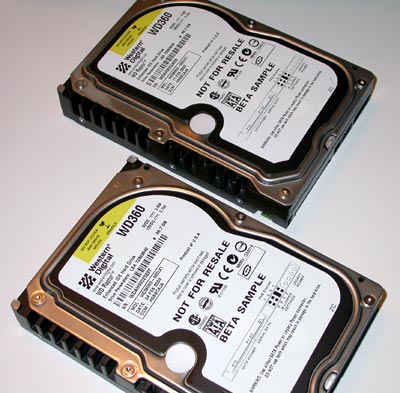Western Digital's Raptor - Part I: The World's Fastest Desktop Drive
by Anand Lal Shimpi on March 11, 2003 7:46 PM EST- Posted in
- Storage
Just last week we previewed Western Digital's brand new enterprise-class drive - the Raptor. The 10,000 RPM hard drive garnered quite a bit of attention, not because of its spindle speed, it's 8MB buffer or its 5 year warranty; the Raptor was thrown into the limelight because it can deliver all the specifications of a high-end SCSI drive, but with a Serial ATA interface.
For years, performance enthusiasts have asked why there hasn't been a 10,000 RPM IDE drive for the desktop, and for years the manufacturers have responded with a lack of demand for such a product.
Western Digital continues to believe that, which is why the Raptor is classified as an enterprise drive and not a successor to their highly successful Caviar line of desktop hard drives. But there are a number of enthusiasts that are using 15,000 RPM Seagate drives in their desktop systems, so the Raptor has a viable user base in a non-enterprise market as well.
All of this discussion about the potential uses for the Raptor is meaningless if the drive cannot deliver world class performance and based on our preview, the Raptor had a lot of growing up to do before it could achieve that goal.
Shortly after we published our preview, we were contacted by a number of other OEMs and system integrators that had been playing around with similar beta samples of the Raptor drive. Everyone that contacted us had similar disappointing performance results, but one company in particular mentioned the possibility that Western Digital disabled write caching on all early Raptor samples. We worked on seeing if there was a way to enable the write cache on our sample, but the end result was that the drive would need a firmware update.

The new and old Raptor
Western Digital contacted us to arrange for a new sample, with write caching enabled, to be provided. They confirmed what we had heard, as well as mentioned that there were other optimizations present in the shipping firmware that weren't there before; by far the biggest performance improvement would be due to enabling write caching. A day later, we had a new Raptor drive in our hands and started putting it through the paces…










7 Comments
View All Comments
rhinofishing1 - Monday, November 17, 2003 - link
I have a AOpen AX4SPE-Max Motherboard which has SATA and Raid support. I was thinking about getting 2 of these drives and setting them at Raid 0 for my system drive. I plan on doing a lot of video editing and using a 200GB drive for my A/V content on a regular IDE master channel. Do you see any problems, or have any suggestions with my setup? Thanks in advance...FASE77 - Sunday, November 2, 2003 - link
HiI have a WD800JB and WD1200JB, i'm really glad to see the WD1200JB performing too well in the test, the only thing I don’t like about the drive is that it has no heat sensor! unlike my older Seagate Barracuda drive (ST360021A).
I really hope Western Digital will start embedding heat sensors into their drives soon.
mrHand - Thursday, October 30, 2003 - link
Re: Post on Aug 3, 2003: I have never had a Western Digital drive lose a single bit of my data. Other manufacturers, yes, but not this one.I have a WDC1600JB that walks all over this SATA drive (I bought one and tried it out). Anybody had a different experience? It could be a BIOS setting...
mrHand - Thursday, October 30, 2003 - link
Anonymous User - Monday, August 25, 2003 - link
Please compare Raptor single drive performance with two Raptors in a Raid 0 configuration. Please compare also with two PATA drives in Raid 0 configuration.Is there a problem with excessive heat being generated by these units.
Thanks.
Anonymous User - Sunday, August 3, 2003 - link
But how is the reliablilty going to be, maybe its just me but western digital drives are notorious for being unreliableAnonymous User - Saturday, August 2, 2003 - link
I have a question about write caches: I have read that many SCSI drives do not by default enable their write caches (enterprise may want safety over performance). Are the two 10K SCSI drives in this article run with their write caches enabled to make the comparison more fair? Given the dramatic increase in the SATA drive's performance with write caching, it could be a significant factor.Another comment: WD's drives looks more like the next generation high performance desktop drive, not a low-cost enterprise alternative to SCSI. Perhaps the follow up benchmarks (4 months in the making?) will shed light on this.